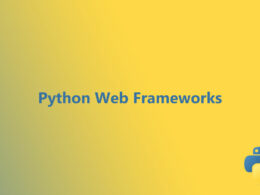Language Processing with Python: Best NLP Libraries

Imagine navigating the labyrinth of human language with the precision of a well-crafted algorithm. Welcoming Python NLP libraries into the fold of your web design toolkit is akin to granting yourself a new lens through which to decipher the intricate dance of written and spoken words.
In an era where content is king, the ability to parse, understand, and manipulate language grows ever more crucial.
As virtual conversations burgeon, sifting through the textual enormity demands automated sentinels, whispering insights into the patterns of human communication.
This article shines a spotlight on a selection of cutting-edge Python NLP libraries, carving out paths for you to enhance text analytics and unveil sentiment classification with unmatched clarity.
By journey’s end, the secrets to computational linguistics prowess will no longer be shrouded in mystery.
Prepare for a tour into:
- The uncharted territories of Named Entity Recognition
- The constructs of Sentiment Analysis
- The essence of creating predictive text models
Within these walls lie the answers, ready for the taking by the astute and the bold.
Python NLP Libraries
| Python NLP Library | Primary Use | Language Support | License | Key Features |
|---|---|---|---|---|
| AllenNLP | Cutting-edge models | English | Apache 2.0 | Deep learning, built on PyTorch, emphasis on research and high-quality code |
| Stanfordnlp | Core NLP tasks | Multiple | GPL v3 (StanfordNLP) | Rule-based and neural network models, Stanford CoreNLP wrapper |
| NLTK | Educational and research | Multiple | Apache 2.0 | Comprehensive, large set of corpora, classic NLP tools |
| Polyglot | Multilingual processing | 100+ languages | GPL v3 | Language detection, tokenization, named entity recognition |
| Gensim | Topic modeling and similarity | English | LGPL | Efficient implementations of word2vec, fastText, LDA |
| Core NLP | Stanford CoreNLP Python Wrapper | Multiple | GPL v3 (StanfordNLP) | Interfaces with Stanford CoreNLP Java library |
| HuggingFace | State-of-the-art models | Multiple | Apache 2.0 | Transformers architecture, pre-trained models, easy model sharing |
| PyTorch | Deep learning frameworks | Multiple | BSD-style | Dynamic computation graph, natural choice for deep learning in NLP |
| TextBlob | Text processing simplification | English | MIT | Simple API for common tasks, sentiment analysis, translation |
| Pynlpl | Corpus linguistic tasks | Multiple | GPL v3 | Parsing, search indexes, vector space modeling |
| fastText | Text classification, embedding | Multiple | MIT | Word representation, language identification |
| TextAttack | Textual adversarial attacks | English | MIT | Benchmarks, attack methods for NLP models |
| Flair | Sequence labeling and embeddings | Multiple | Apache 2.0 | Pre-trained models for NER, POS tagging, and state-of-the-art embeddings |
| SpaCy | Industrial-strength NLP | Multiple | MIT | Fast, syntactic parsing, named entity recognition, ready for production |
| Scikit-learn | Machine learning in Python | Multiple | BSD | Various algorithms for classification, clustering, dimensionality reduction |
| OpenNLP | NLP toolkit (Java-based, Python wrapper) | Multiple | Apache 2.0 | Tokenization, sentence splitting, POS tagging, parsing |
| Pattern | Web mining | Multiple | BSD | Web scraping, sentiment analysis, machine learning |
| Natural Language Toolkit | Alias for NLTK | Multiple | Apache 2.0 | (Same as NLTK) |
| Vocabulary | Vocabulary management | English | MIT | Word definitions, synonyms, antonyms, translations |
AllenNLP
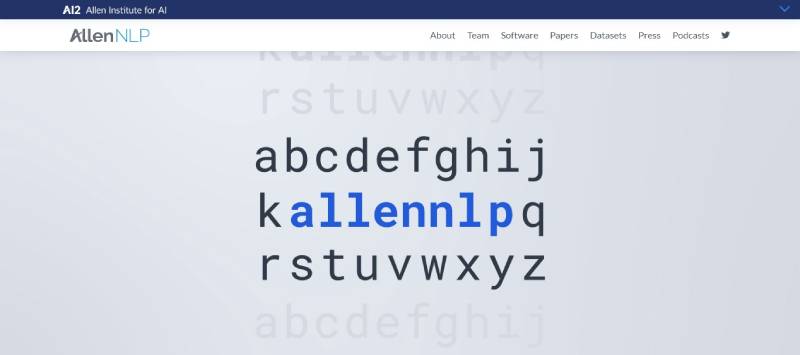
As the artisan of AI research in natural language processing, AllenNLP flexes its muscles best when delving into sophisticated deep learning models. A library furnished by the AI2 (Allen Institute for AI), it whittles down the complexity of machine learning algorithms into elegant, human-readable abstractions.
Best Features:
- Pre-trained models
- Modular and extensible
- Easy model sharing
What we like about it: The most invigorating quirk—a penchant for turning deep learning research into practice swiftly and cleanly. The modular design ensures even the lexically rich language models become accessible tools in the hands of those who dare to dream.
StanfordNLP
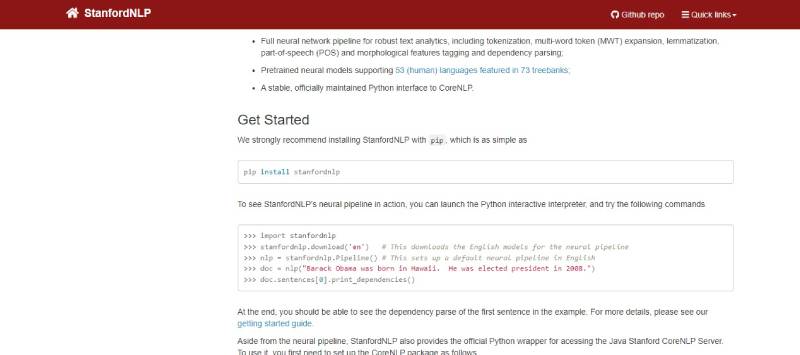
In the realm where linguistic scholars meet coding crusaders, StanfordNLP stands tall. With a syntactic analysis prowess unparalleled, this behemoth of NLP originates from one of the most prestigious universities known to humanity. Its forte includes a vast array of human languages, each treated with the meticulous care of a master linguist.
Best Features:
- Multilingual support
- High accuracy
- Robust annotations
What we like about it: What’s not to adore about precision? The high accuracy of its neural network processing makes it coveted among aficionados of semantic accuracy and syntactic tree parsing. It’s truly the cornerstone of multilingual NLP work.
NLTK
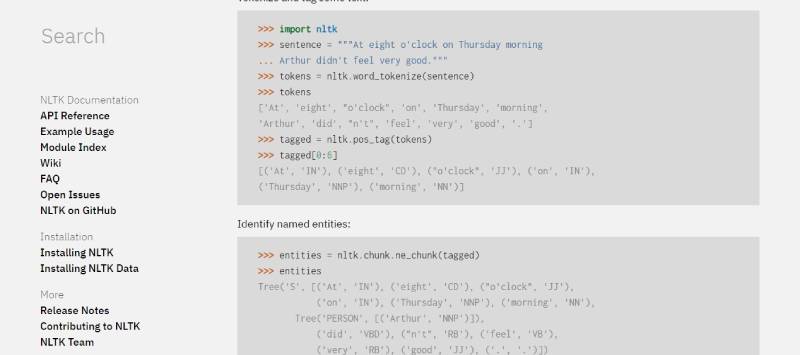
For those with ambition to glean natural language understanding but wanting a gentle introduction, NLTK serves as the perfect primer. Established as a powerful educational tool, its library spills over with easily digestible algorithms and datasets, proving itself as the bedrock for fledgling coders and seasoned text miners alike.
Best Features:
- Comprehensive toolkit
- Wide range of tutorials
- Expansive corpus collection
What we like about it: The crown jewel—its corpus building capacities. It hosts an exhaustive selection, resplendent with the capability to feed any topic modeling or sentiment analysis endeavor.
Polyglot
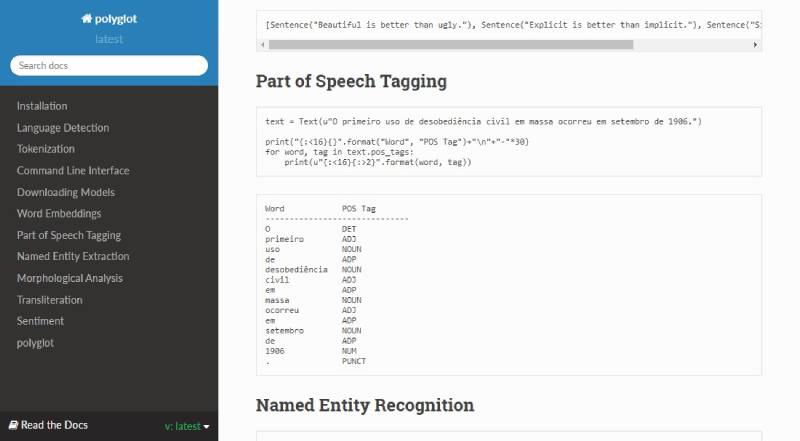
When the conversation turns to multi-language NLP support, the Polyglot library is mentioned with a nod of respect. Favoring the adventurous, it stands as a bastion for language detection and varied natural language tasks on a cornucopia of dialects spanning the earth’s expanse.
Best Features:
- Supports over 100 languages
- Entity recognition
- Language detection
What we like about it: Most lauded is its polyglot nature—a traveler through tongues, perceiving and articulating through a spectrum of languages with the ease of a global citizen.
Gensim
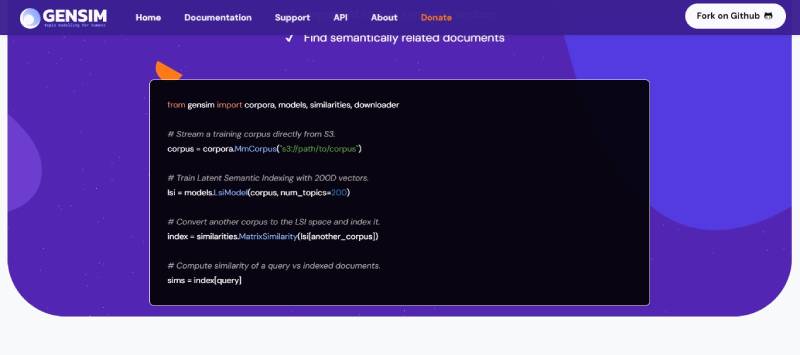
Gensim excels as the silent engine room of topic modeling and vector space modeling. Its name, derived from “generate similar”, mirrors its primary objective—understanding documents by distilling their core themes. Built for the manipulation and analysis of large text collections, it’s a heavyweight in unsupervised semantic space.
Best Features:
- Scalability
- Efficient implementations of algorithms
- Robust topic modeling capabilities
What we like about it: The standout? Its nimble handling of immense text corpora with elegance and minimal memory requirement. For textual enormity, Gensim is like a master key, unlocking layers of latent thematic content with ease.
CoreNLP
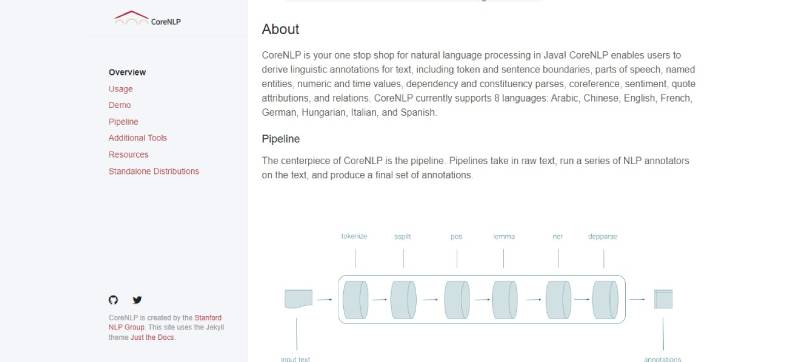
CoreNLP is the breadwinner for the Stanford suite, comprehensive enough to tackle the full spectrum of NLP tasks. With a suite of tools packed into one-stop annotation, it’s a library that landfills the need to jump between multiple platforms.
Best Features:
- Broad NLP toolset
- Seamless integration
- Robust community resources
What we like about it: The versatility stands out—it is not just a library but a complete end-to-end toolkit. The sheer range of tasks CoreNLP simplifies, from lexical resources sorting to neural parsing, steals the spotlight.
Hugging Face
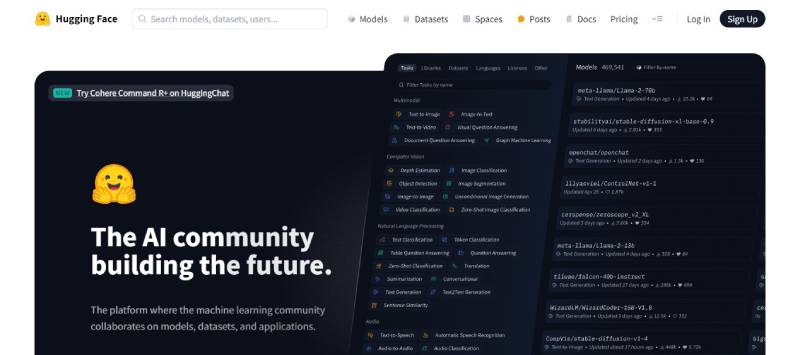
If NLP had its own social network, Hugging Face would be the charismatic influencer. This library signals the evolution of deep learning integration in NLP, providing a friendly face to the otherwise intimidating GPT and BERT models. It is, without a doubt, a herald of the transformer era.
Best Features:
- State-of-the-art pre-trained models
- User-friendly interface
- Cutting-edge transformer architectures
What we like about it: Above everything, its commitment to democratizing AI stands out. By making the most powerful models like BERT and GPT accessible, it galvanizes the community around open, reproducible research.
PyTorch

In the heat of the machine learning forge, PyTorch shines with the glow of innovation. Loved by researchers for its flexibility and by developers for its ease of deployment, it’s more than an NLP library—it’s a machine learning framework that’s redefining the norm.
Best Features:
- Dynamic computation graphs
- Robust community support
- Seamless production deployment
What we like about it: Dynamic computation graphs—allowing the winged horses of creativity to take flight mid-run. It’s not just about the NLP tasks at hand but how fluidly PyTorch can adapt to the ever-changing research landscape.
TextBlob
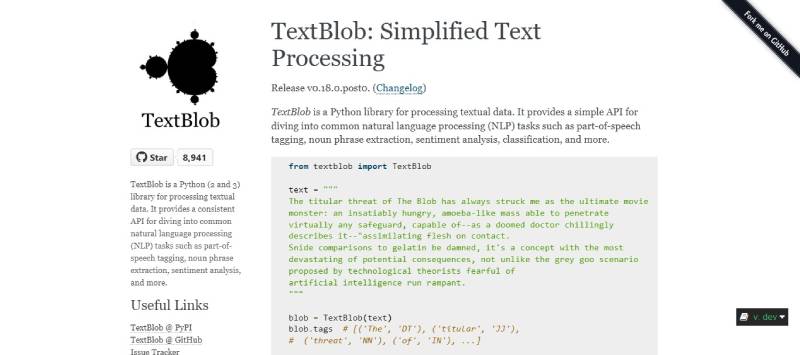
TextBlob wraps up complex NLP tasks in a downy blanket of simplicity. Catering to both beginners and pros, it metamorphoses daunting algorithms into gentle, low-entry barriers, inviting even the most hesitant to dabble in the poetic world of NLP.
Best Features:
- Beginner-friendly
- Interfacing with NLTK and Pattern
- Sentiment analysis tools
What we like about it: Sentiment analysis tools twinkle the brightest in TextBlob’s constellation. Even an NLP layman can chart a course through the sentiment classification terrain and extract mood textures from clauses within moments.
fastText

fastText sprints ahead to simplify and hasten our grasp over text classification and word embedding generation. Birthed by the minds at Facebook AI Research (FAIR), it leverages neural networks in its quest to imbue machines with the nuances of word representations and language parsing.
Best Features:
- Efficient text classification
- Pre-trained word vectors
- Resource-friendly representation
What we like about it: The raw speed and efficiency with which it handles text miner tasks stand out like a beacon. fastText’s revolution is not just its prediction quality but how swiftly it reaches the finish line, making it a favorite sprinter in the NLP race.
TextAttack
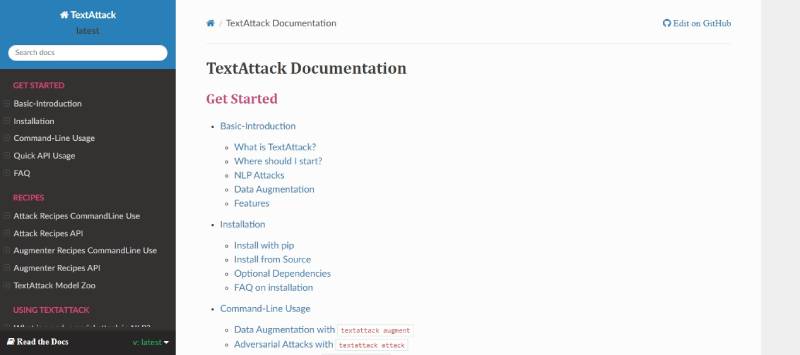
TextAttack is the arsenal we didn’t know we needed, built to challenge and improve our NLP models through adversarial attacks. It’s a platform inviting innovation, scrutiny, and robustness testing, ensuring our language models do not falter when faced with the unpredictable elements of human text.
Best Features:
- Adversarial attack recipes
- Model evaluation
- Dataset augmentation
What we like about it: What’s praised is its facility to toughen NLP models against linguistic adversities. In a landscape rife with linguistic curveballs, TextAttack proves to be the ultimate sparring partner for language model resilience.
SpaCy
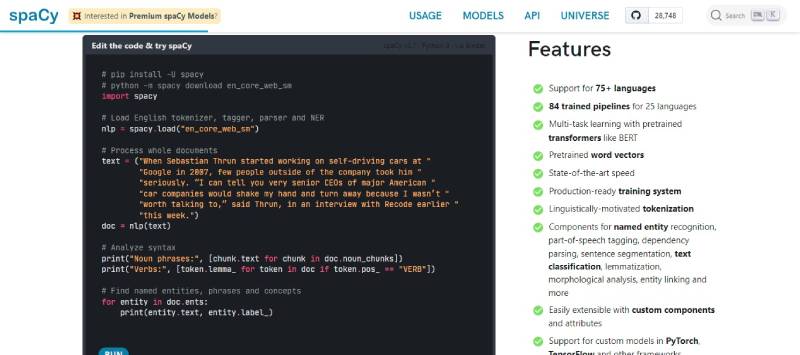
SpaCy approaches NLP with the elegance of a cultivated script, offering a garden of linguistic resources tailored for production-ready applications. Its agility and performance make it the pythonic conductor for advanced NLP tasks, all while maintaining linguistic rigor and enterprise-level scalability.
Best Features:
- Industrial-strength
- In-built word vectors
- Production-ready
What we like about it: The precision it brings to language parsing is a spectacle to behold, refining syntactic analysis to a clockwork science. Companies and developers alike gravitate towards SpaCy’s neural network processing capabilities, making it the linchpin of many production-grade NLP applications.
Scikit-learn
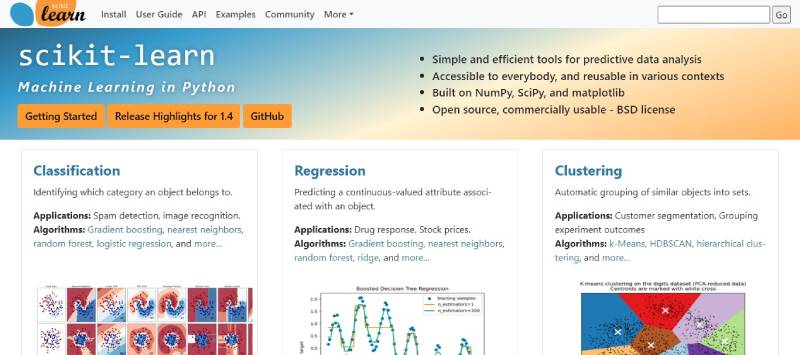
Scikit-learn, where the mathematical heart of machine learning meets the linguistic soul of NLP. Though not exclusively an NLP library, its algorithms for classification, regression, clustering, and dimensionality reduction are a springboard for feature extraction in natural language tasks.
Best Features:
- Wide range of machine learning algorithms
- Detailed documentation
- Strong community support
What we like about it: What Scikit-learn garners admiration for is its versatility. With text classification algorithms at your disposal, the transition from computational linguistics theorem to engineered systems becomes smooth as silk.
OpenNLP
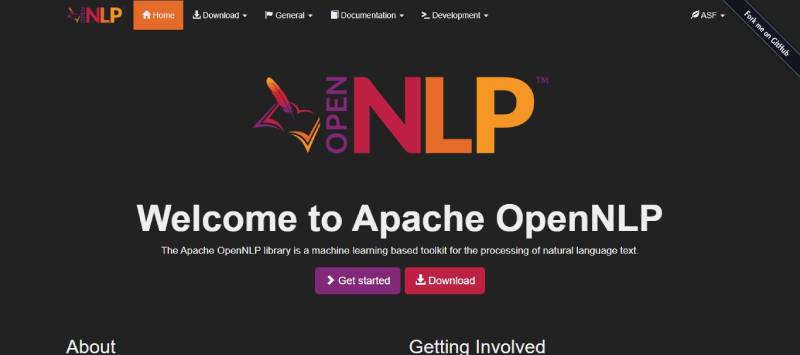
Dressed in a coat of robust natural language processing capabilities, OpenNLP stands ready to dissect text with a keen eye. As a toolkit that carries out the essentials—tokenization, sentence splitting, part-of-speech tagging, and more—OpenNLP excels in laying the groundwork for complex linguistic analysis.
Best Features:
- Comprehensive NLP tasks coverage
- Integration with Apache UIMA
- Extensive training tools
What we like about it: The most compelling aspect? Its uncanny proficiency in named entity recognition. OpenNLP charts the territory of human language with such neural network processing finesse that entities within text aren’t just found; they’re understood.
Natural Language Toolkit (NLTK)
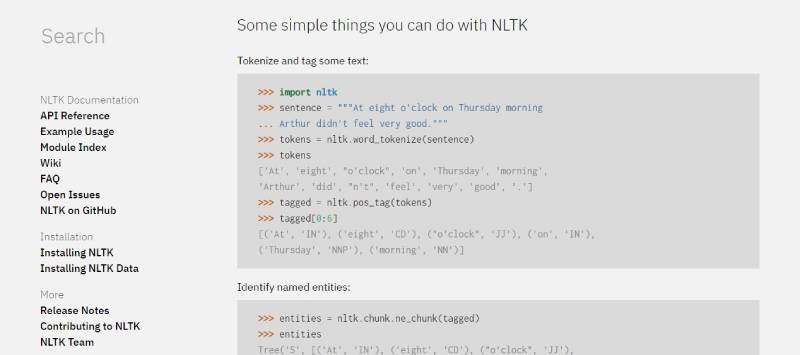
The Natural Language Toolkit or NLTK, is a veteran in the world of Python NLP libraries. Its toolbox is brimming with linguistic goodness—from corpus building to sophisticated classification, this library has been the starting block for many in their journey through language computation.
Best Features:
- Comprehensive algorithms and data sets
- Good for both research and education
- Active community
What we like about it: By far, its educational value is the crowning feature. As a springboard for newcomers, it demystifies the complexities of various NLP techniques into manageable learning experiences, fostering growth in both the computational linguistics field and practical application development.
FAQ On Python NLP Libraries
What is the purpose of using Python NLP libraries?
Python NLP libraries are employed to dissect and interpret language data, enhancing text analytics and information extraction.
These solid frameworks streamline processing spoken or written discourse, crucial in an atmospheric digital landscape where data is voluminous and insights are pivotal.
How do Python NLP libraries handle different languages?
Python NLP libraries like spaCy and NLTK come with multilingual support, opening doors to multi-language NLP abilities.
Equipped with pre-trained linguistic analysis models, they adeptly manage various language intricacies, broadening the spectrum of automatic language detection and processing.
Can Python NLP libraries be used for sentiment analysis?
Indeed, Python NLP libraries excel in sentiment classification, deploying robust algorithms to sieve through textual nuances.
They pinpoint emotional undercurrents, offering businesses critical sentiment rating evaluations from customer feedback, thus guiding data-driven actions.
Which Python NLP library is the best for beginners?
For novices dipping toes into natural language water, the Natural Language Toolkit (NLTK) beams as a guiding star.
Its comprehensive suite of linguistic resources coupled with Python text analytics pedagogy makes it accessible and illuminating, especially for Python NLP tutorials aimed at beginners.
What is the role of machine learning in Python NLP libraries?
Machine learning is the lifeblood of Python NLP libraries, fueling predictive text modeling and automating language generation. By continuously learning from corpuses, machine-learning models within these libraries adapt to yield increasingly precise linguistic predictions.
Do Python NLP libraries support speech recognition?
While traditionally focused on text, some Python NLP frameworks venture into speech to text conversion. Libraries like SpeechRecognition bridge this divide, transforming oration into text, unlocking avenues for speech recognition modules within Python’s empire.
How do I choose the right Python NLP library for my project?
Consider your project’s scope and requirements, such as text classification algorithms, lexical resources, or sentiment analysis capabilities.
Remember, each library, from spaCy’s sophistication in neural network processing to Gensim’s might in topic modeling, wields unique strengths.
Are Python NLP libraries difficult to learn?
The learning curve can be steep, but it’s not insurmountable—it hinges on the library and your familiarity with Python and computational linguistics. Tutorials, practice, and community forums are lighthouses guiding you through the NLP storm.
How are Python NLP libraries used in web development?
In the web’s Fabric, Python NLP libraries serve as artisans, shaping SEO-friendly content or powering intelligent chatbots. They enhance user experience by ensuring content relevancy and automatic summarization in Python-based applications, offering a seamless digital journey.
What advancements in Python NLP can we expect in the future?
Expect NLP Python libraries to keep evolving, with improvements in language model training and deeper learning integrations.
Future strides will refine algorithms for even more nuanced natural language understanding, computational linguistics research, and predictive text modeling, fortifying the NLP landscape’s foundations.
Conclusion
Venturing through the vibrant maze of Python NLP libraries, one emerges with a profound realization—the intrigue of language, once solely the realm of poets and writers, has become a programmable artifact. These tools have woven simplicity into the complex web of human interaction, offering a tapestry through which we comprehend the digital chatter.
- Multilingual models constructed from these libraries bridge communication chasms, their algorithms a neural network processing marvel.
- Sentiment analysis, once an enigma, now distilled to numbers and charts, offers businesses a lighthouse in a sea of customer opinions.
- The once-daunting lexical resources have been tamed into textual enormity manageable by a single line of code.
As we step out from the illuminating journey into these archives, recognize the quiet revolution unfurling beneath your fingertips—where code meets the curvature of human speech, and understanding becomes the currency in an economy of words.
If you liked this article about Python NLP libraries, you should check out these articles also:
- Math Made Easy: Best Apps Like PhotoMath
- Photo Enhancement: Must-Try Apps Like Lensa
- Organize Your Thoughts with Apps Like Notion
- Understanding JavaScript Array.length for Data Handling - June 26, 2024
- Red Flags to Watch for When Hiring an Affordable Website Design Agency - June 26, 2024
- How Flutter Enhances Video App Creation Across Platforms - June 26, 2024






